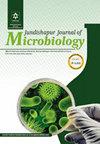Azole Resistance in Candida albicans Isolates from Oropharyngeal Candidiasis is Associated with ERG11 Mutation and Efflux Overexpression
IF 0.5
4区 医学
Q4 MICROBIOLOGY
引用次数: 0
Abstract
Background: Azole resistance rates are rising in Candida species. Fluconazole is one of the most important antifungal drugs used in candidiasis treatment. Objectives: We identified the molecular mechanisms of fluconazole resistance of Candida albicans oropharyngeal candidiasis (OPC) isolates obtained from head and neck cancer patients, a study carried out between 2018 and 2020. Methods: One hundred and twenty-five Candida albicans clinical isolates were collected. Antifungal susceptibilities were determined by the CLSI- M27-A3 method. The ERG11 gene was amplified and sequenced to discover SNP mutation. Moreover, real-time PCR was carried out to measure the mRNA levels of ERG11, CDR1, CDR2, and MDR1. Results: Resistance to fluconazole was found in 15 C. albicans isolates. Amino acid substitutions E266D and D116E were observed in resistant, sensitive dose-dependent (SDD), and susceptible C. albicans isolates. K128T, G465S, A114S, Y257H and V488I were in relation to fluconazole resistance. D504A, P375A, W520C, G59S, and V51L were novel substitutions detected in the isolates; except for D504A, other mutations were observed only in resistance isolates. The expression levels of CDR2, CDR1, MDR1, and ERG11 were increased compared to susceptible isolates, respectively. Conclusions: ERG11 mutation was the principal mechanism for fluconazole resistance in C. albicans isolated from oropharyngeal candidiasis patients, and caspofungin can be used as the effective antifungal substance in fluconazole resistance situation for C. albicans infection.口咽念珠菌病白色念珠菌对唑的耐药性与ERG11突变和外排过表达有关
背景:念珠菌对唑的耐药性正在上升。氟康唑是治疗念珠菌感染最重要的抗真菌药物之一。目的:我们确定了2018-2020年间从癌症头颈部患者中获得的白色念珠菌口咽念珠菌感染(OPC)分离株对氟康唑耐药性的分子机制。方法:收集125株白色念珠菌临床分离株。采用CLSI-M27-A3法测定其对真菌的敏感性。对ERG11基因进行扩增和测序,发现SNP突变。此外,进行实时PCR以测量ERG11、CDR1、CDR2和MDR1的mRNA水平。结果:15株白色念珠菌对氟康唑产生耐药性。在耐药性、敏感性剂量依赖性(SDD)和易感白色念珠菌分离株中观察到氨基酸取代E266D和D116E。K128T、G465S、A114S、Y257H和V488I与氟康唑抗性有关。D504A、P375A、W520C、G59S和V51L是在分离株中检测到的新的取代;除D504A外,其他突变仅在耐药菌株中观察到。与易感分离株相比,CDR2、CDR1、MDR1和ERG11的表达水平分别增加。结论:ERG11突变是口咽念珠菌感染白色念珠菌对氟康唑耐药的主要机制,卡泊芬净可作为治疗白色念珠菌氟康唑耐药性的有效抗真菌物质。
本文章由计算机程序翻译,如有差异,请以英文原文为准。
求助全文
约1分钟内获得全文
求助全文
来源期刊

Jundishapur Journal of Microbiology
MICROBIOLOGY-
CiteScore
1.30
自引率
0.00%
发文量
56
审稿时长
6-12 weeks
期刊介绍:
Jundishapur Journal of Microbiology, (JJM) is the official scientific Monthly publication of Ahvaz Jundishapur University of Medical Sciences. JJM is dedicated to the publication of manuscripts on topics concerning all aspects of microbiology. The topics include medical, veterinary and environmental microbiology, molecular investigations and infectious diseases. Aspects of immunology and epidemiology of infectious diseases are also considered.
 求助内容:
求助内容: 应助结果提醒方式:
应助结果提醒方式:


